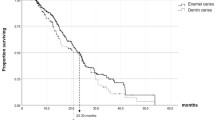Abstract
Aim: This was to investigate survival rate, median survival time and differences in the progression of different stages of proximal caries in 196 children, aged 6 to 8 years old, with different caries index at baseline examination. Methods: Based on DMFS/dmfs values, children were categorized as low, moderate and high caries index groups. Subjects with DMFS/dmfs smaller or equal to half of a child’s age were classified as low caries index group; children with DMFS/dmfs greater than half and smaller than, or equal to, the child’s age as moderate; those with DMFS/dmfs greater than the child’s age as high. Proximal caries and its progression were diagnosed from bitewing radiographs taken at 1 — year intervals over a period of 4 years. The mesial surface of the first permanent molars, mesial and distal surfaces of the first and second primary molars and distal surfaces of the primary canines were examined. Sound surfaces, caries lesions in the external and internal half of the enamel and external, middle, internal third of the dentine as well as filled, extracted and exfoliated teeth were recorded. Statistics: A life table analysis was performed to estimate survival rate and median survival time of each state of proximal caries and differences between the groups in the progression of the proximal lesions were tested with the Wilcoxon pairwise comparison statistic. Results: There were statistically significant differences in the caries rate of the sound proximal surfaces of the primary teeth between the low and high caries index groups. Also, statistically significant differences between these two groups were found in the progression of the external half of the enamel caries in the first permanent molars and in the primary teeth. Conclusions: A high caries index increases the risk of developing caries in the sound proximal surfaces of posterior primary teeth and causes faster progression of the external half of the enamel lesions in the first permanent molars and posterior primary teeth.
Similar content being viewed by others
References
Clark HC and Curzon MEJ: A prospective comparison of the clinical yield from bitewing and panoramic radiographs for dental caries diagnosis in children. Eur J Paediatr Dent 2004; 5:203–209.
Gustafsson A, Svenson B, Edblad E, Jansson L: Progression of approximal carious lesions in Swedish teenagers and the correlation between caries experience and radiographic behaviour. An analysis of the survival rate of approximal caries lesions. Acta Odontol Scand 2000; 58:195–200.
Hintze H, Wenzel A, Danielsen B: Behaviour of approximal carious lesions assessed by clinical examination after tooth separation and radiography: a 2.5-year longitudinal study in young adults. Caries Res 1999; 33:415–422.
Machiulskiene V, Nyvad B, Baelum V: A comparison of clinical and radiographic caries diagnoses in posterior teeth of 12-year-old Lithuanian children. Caries Res 1999; 33:340–348.
Mejare I, Kallestal C, Stenlund H: Incidence and progression of approximal caries from 11 to 22 years of age in Sweden: a prospective radiographic study. Caries Res 1999; 33:93–100.
Nyvad B, Machiulskiene V, Baelum V: Reliability of a new caries diagnostic system differentiating between active and inactive caries lesions. Caries Res 1999; 33:252–260.
Pliskin JS, Shwartz M, Grondahl HG, Boffa J: Reliability of coding depth of approximal carious lesions from non-independent interpretation of serial bitewing radiographs. Community Dent Oral Epidemiol 1984; 12:366–370.
Shwartz M, Grondahl HG, Pliskin JS, Boffa J: A longitudinal analysis from bitewing radiographs of the rate of progression of approximal carious lesions through human dental enamel. Arch Oral Biol 1984; 29:529–536.
Stenlund H, Mejare I, Kallestal C: Caries rates related to approximal at ages 11–13: a 10-year follow-up study in Sweden. J Dent Res 2002; 81:455–458.
Tinanoff N, Douglass JM: Clinical decision making for caries management in children. Paediatr Dent 2002; 24:386–392.
Vanderas AP, Manetas C, Papagiannoulis L: Urinary catecholamine levels in children with and without dental caries. J Dent Res 1995; 74:1671–1678.
Vanderas AP, Manetas C, Koulatzidou M, Papagiannoulis L: Progression of proximal caries in the mixed dentition: a four-year prospective study. Paediatr Dent 2003; 25:229–234.
Vanderas AP, Kavvadia K, Papagiannoulis L: Development of caries in first permanent molars adjacent to second primary molars with interproximal caries: four-year prospective radiographic study. Paediatr Dent 2004; 26:362–368.
Author information
Authors and Affiliations
Corresponding author
Rights and permissions
About this article
Cite this article
Vanderas, A.P., Gizani, S. & Papagiannoulis, L. Progression of proximal caries in children with different caries indices: A 4-year radiographic study. Eur Arch Paediatr Dent 7, 148–152 (2006). https://doi.org/10.1007/BF03262556
Published:
Issue Date:
DOI: https://doi.org/10.1007/BF03262556




